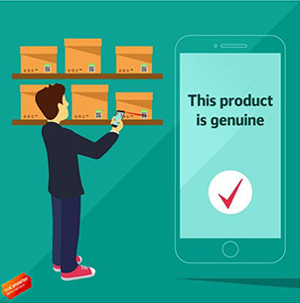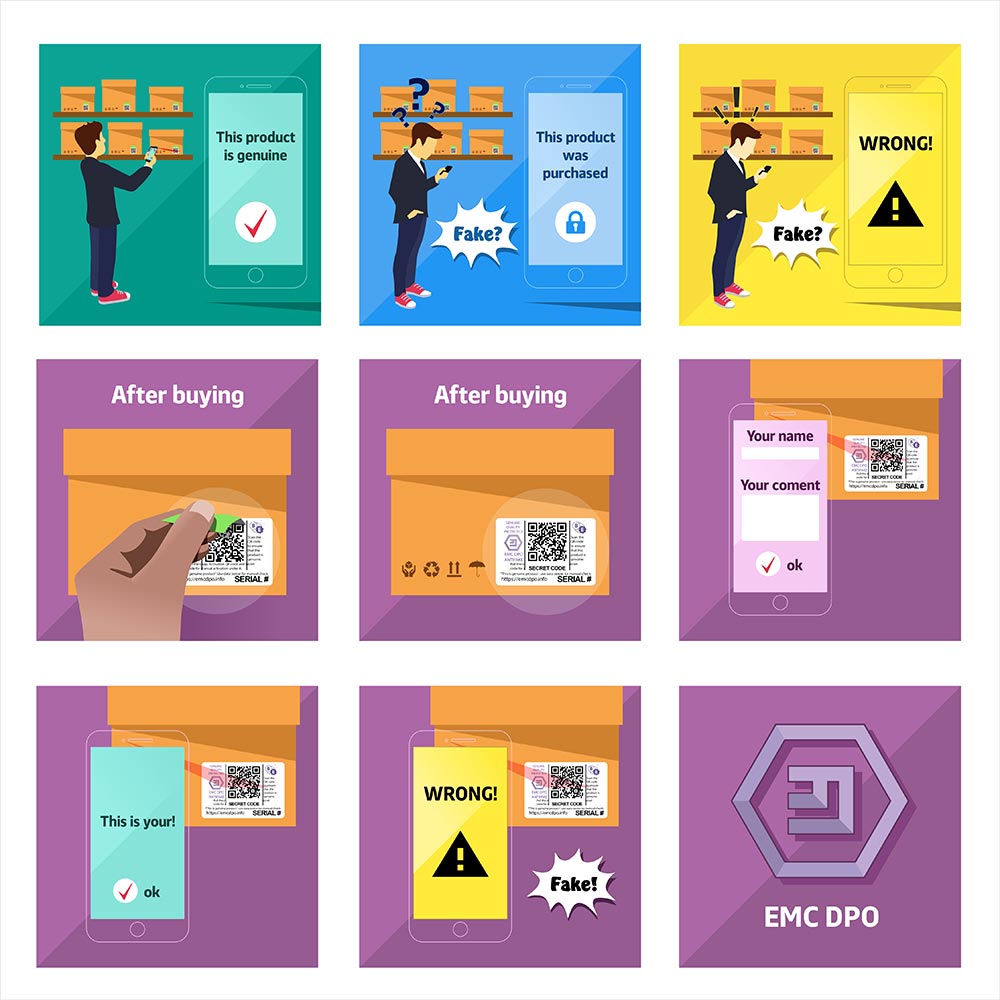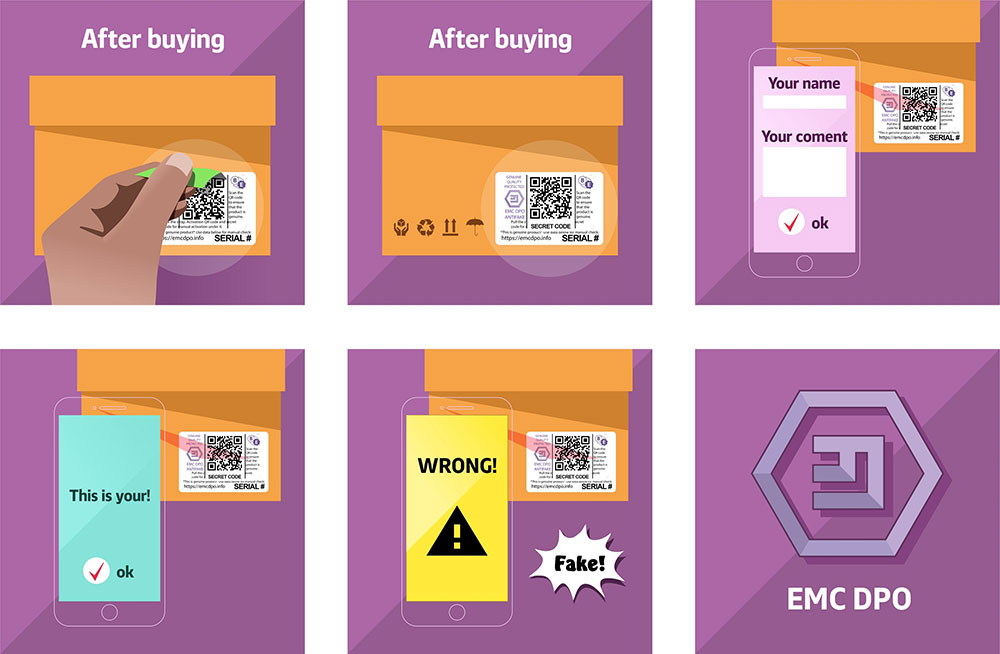
The EMC Antifake programme
Functioning on the Emercoin platform, EMC Antifake is an anti-counterfeit and product tagging system that uses Emercoin's EmerDPO blockchain technology.
EMC Antifake allows manufacturers to create a unique ID or "digital passport" for each and every product unit that comes off their production line. These "digital passports" are stored by the manufacturer in Emercoin's secure blockchain, thus allowing the manufacturer and their customers to verify the authenticity of every product.
Counterfeiting damages brand reputation and creates cautious customers which hurts sales. EMC Antifake solves the counterfeiting problem for manufacturers, while the non-replicable "digital passport" provides a valuable bridge between customer and product.
The "digital passport":
- can be used by manufacturers to record all events occurring during the lifetime of the product e.g. manufacture, sale, resale, service, repair, etc.
- provides a technologically enhanced customer experience that guarantees security allowing confident purchase decisions while also deterring against theft.
- allows for better communication from customers, increasing the customer's sense of individual connection with the brand and product.
- allows for better communication to customers e.g. offering loyalty bonuses or other incentives like discounts, extended warranties, etc, helping the brand better understand their customers.
Thanks to the tools provided by the Emercoin team, all that is (minimally) required from a product manufacturer is to apply specialized tags or labels to their products. Optionally, the manufacturer can install a specific security program for analysis of sales data, though this isn’t required and may be done after deployment.
The EMC Antifake technology is available to try now - and it won’t cost anything. EMC Antifake is in the pilot stage and the Emercoin team are ready to provide introductions to the technology and assist with the tools necessary for successful product integration and launch.
How does it work in a practical sense?

For products still at the factory (or distributor’s storage), QR codes in the form of a label or tag are applied to each package. Each individual product gets its own unique tag, containing a unique serial number given to it by the manufacturer. A second code – the "purchase code" – exists inside the packaging of the product, or on the inside of a two-layered tag (see image).
In the store, the customer scans the code with their smartphone. There is no specialized app required (almost all smartphones have a QR code scanner app built-in or easily available).
For a genuine, unsold product, a page will be displayed providing information about the product and the manufacturer, confirming that the product has not been purchased before, and that it is authentic.
After a customer buys the product, the other code can be accessed (inside the product packaging or by tearing off the top layer of the two-layered tag). When the second code is scanned, another page will open, on which the code undergoes cryptographic verification, and if the product is authentic (because the code is authentic), the customer will be able to register their purchase.
Upon registration the customer may have the ability to create an account or interact with the manufacturer of the product in other ways (for instance, to leave comments), and can also take ownership with a record in the blockchain.
Optionally, the manufacturer may ask the customer to answer a survey, or to fill out their profile, motivating them to do so in various ways (extended warranty, cashback bonus, service opportunity, future discounts, etc). The digital passport allows the manufacturer to verify the authenticity of the customer.
Attackers who try to forge goods can not make valid serial numbers tied to the manufacturer without having the cryptographic keys that the manufacturer possesses.
If an attacker manufactures fake tags with nonexistent codes, they will not be recognized by the system, and customers will be warned when trying to verify the code.
If an attacker purchases a product and copies the tag multiple times onto their own products, the system will know that the product has already been purchased and after the first purchase of any forged product will warn all subsequent potential customers. On top of that, the product initially purchased by the attacker can be marked "unauthorized", which may help, among other things, to identify the criminal.
Only the holder of the manufacturer's private cryptographic key can produce valid labels capable of passing verification. It is important to note that due to the nature of public-key cryptography, even the software developers and verification websites cannot create fake labels that would pass verification tests. In practice, there may be a single existing private key kept secret by the CEO of the manufacturing company (though we strongly recommend keeping backup copies in reserve) and without that key, no one can make a label that will pass the test!
Also note that, cryptographic tokens ("coins", "crypto-currencies") are not used in the verification process, so the EMC Antifake authentication technology itself cannot be subject to any crypto-currency related regulations that may otherwise apply.
Example scenarios
You (manufacturer) would like us to create a series of test tags for you
If you are a manufacturer who would like our help to trial EMC Antifake during its pilot stage then please contact the Emercoin team today. During the pilot we may be willing to take on all of the work, to produce several dozen labels for you and provide the required cryptographic keys, all free of charge within the timeframe of a few days. All you'll need to do is apply the labels to your products.
You (manufacturer) would like to learn how to implement EMC Antifake yourself
There are several possible workflows to accomplish this - whether you do everything yourself (in this case you don't need to contact us at all - just download the software, configure verification servers if you don't want to use ours, create keys and serial numbers), or in the simplest case (when you only create keys and serial numbers using the opensource utility that we can provide you, and leave the rest of the work for us to undertake), the most time-consuming operation will be applying the labels to your products.
You're a customer in a store

Using your smartphone (no specialized app required) you scan the tag on a product.
If the code is valid then a web page opens (similar to this) displaying information about the manufacturer and that particular product, and informing you that the product is genuine and for sale. In that case, if you like the product you can go ahead and buy it with an added sense of security!
However, if the code is invalid, there will either be no page, or a page with an error message. In the case that an attacker copied a tag from an original product and reproduced it, you will receive a warning message that the product has already been purchased (similar to this).
After buying a genuine product

After purchase, you reveal the "purchase code" by tearing off the outer layer of the two-layer tag (see picture) or as otherwise placed inside the packaging of the product by the manufacturer. Scanning this code opens a web page that will allow you to register the purchase, create a user account, receive incentives or bonuses from the manufacturer, or even transfer ownership of the product to another person.
After your purchase has been recorded, you can log in using the details that were provided to you during registration, to manage your purchase. Scanning either code again will result in a page declaring that the product has already been purchased.
The manufacturer may create loyalty programs in which customers can optionally choose to participate. These could include surveys (which may provide additional incentives), improved terms of service, discounts, etc. Thanks to the "digital passport", it will be easy to prove that you purchased a genuine product.
When you first register a purchase, your purchase record (or "digital passport" for the product) is controlled by the issuer, but they may allow you to request its transfer to your Emercoin address to store it yourself. Blockchain technology makes this possible, and after the transfer of the record, no one (not the issuer, or even the Supreme Court) will be able to take away your control (possession) of this record - unless you yourself wish to transfer it to another person.
Somebody stole your item
That is bad news. The good news is, that as long as the serial number is inscribed somewhere on the product - anyone knowing about the EMC Antifake system can potentially report the theft of the item or report its recovery, an unwary thief may be more likely to be caught, and the police will find it much easier to find you and return your stolen property. And in the best of cases, the use of EMC Antifake may even deter the thief from stealing the item in the first place.
EMC Antifake is by no means an absolute defense against theft. However, it provides real mechanisms to reduce its risk and improves chances of item recovery.
You (the manufacturer) wish to receive more feedback from customers
EMC Antifake ensures that manufacturers are interacting only with genuine customers thanks to the "digital passport" verifying customer's purchases. This allows you to speak directly to your customers and motivate them (perhaps with additional incentives) to participate in surveys, provide information about themselves, etc.
Some methods of motivation have already been suggested – including discounts, special services, extended warranties and much more.
Because all records exist on the Emercoin blockchain, you can even motivate the customer by transferring rewards directly to the record's associated payment address on the Emercoin blockchain! In this case, the manufacturer does not have to know anything about the customer, and the system will continue to function even in the case that the record of ownership is transferred to another person! In essence, you have in your hands an "eternal reliable phone" connection with the customer that owns your product – just don’t forget to motivate them to answer!
How much does this cost?
The cost of entering one name in the Emercoin blockchain using Emercoin NVS, is approximately 0.2 EMC (US\$0.04 as of the beginning of 2017). The cost of printing a tag depends heavily on the volume and the size of the label and can come at about 5-10 cents even for smaller volumes. For large volumes, these figures will of course be significantly lower. When compared to the cost to produce an average product, the cost becomes nearly invisible. Ongoing costs for the operation of the system are practically nil for any significant volume.
More info
- See the following article on medium: How to protect your products against counterfeiting using Blockchain.
- Please contact the Emercoin team if you would like to join our pilot program.
- You can also visit EmerDPO.info